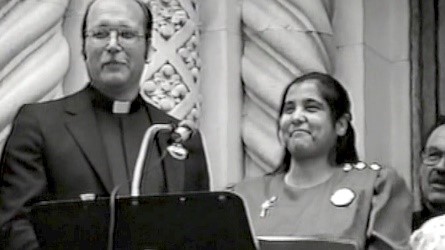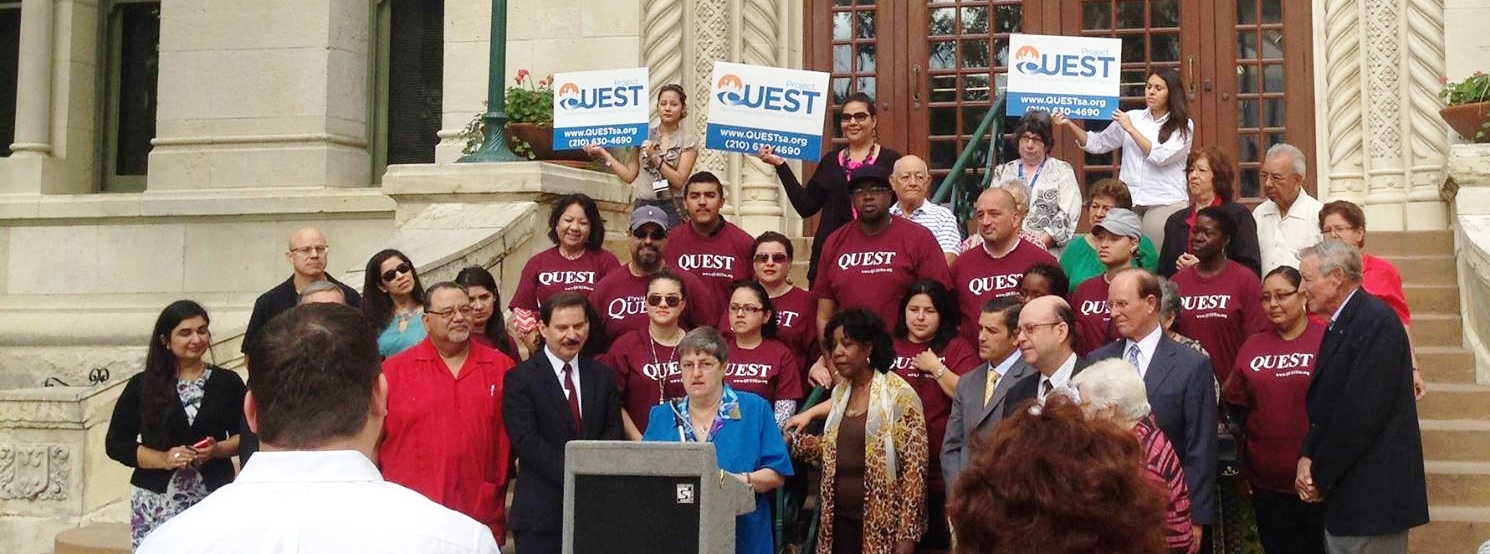By Carol Baass Sowa for Today’s Catholic
When the Levi Strauss jeans manufacturing plant in San Antonio closed in 1990, it was the culmination of several local plant closings and the effect was devastating. “Two thousand people on the southside of San Antonio lost their jobs,” relates Sister Pearl Ceasar, CDP, superior general of the Congregation of Divine Providence. In those days, she was lead organizer for the Metro Alliance.

There had been a change in the economy throughout the United States during the 1980s, she explains, with the vanishing of middle-class jobs, primarily in manufacturing, that required lower-skilled labor but paid a middle-class wage. People could move into such jobs straight from high school graduation.
Since most of those losing jobs were from South Side churches whose pastors belonged to Communities Organized for Public Service (COPS), it was only natural that they turned to these priests for help. Sister Pearl remembers Father Al Jost, OFM, of St. Leonard Parish telling of waking up to the news of the plant closing and a parishioner’s voice asking, “What are we going to do?”
Groundwork had already been laid in this regard, Sister Pearl notes, with seminars held by the Industrial Areas Foundation (IAF) in the late 1980s and early 90s on the changing economy, under the leadership of Ernesto Cortés Jr. in the Southwest Region. COPS, a church-based, grass roots organization of San Antonio’s West Side and South Side parish communities, had come about through the IAF in 1974. In the early 1980s, two other IAF-affiliated organizations, the Metropolitan Congregational Alliance (MCA), from the south central and northwest areas of town, and the East Side Alliance (ESA) would merge to form the Metro Alliance, which in turn partnered with COPS in 1989.
COPS organizer Tom Holler was initially brought in to oversee what would be 500 house meetings of around 5,000 individuals organized in parishes to address the sudden job loss. These small groups focused specifically on discussing individual work experiences and what was needed to retrain people for new jobs.
It was evident the type of jobs previously held were disappearing and that the jobs needing applicants were higher-skilled positions, primarily in healthcare, which required special training. However, the only training programs available were for lower skill jobs paying far less than what the Levi Strauss employees had been making. Attending community college for higher skill training was not a solution either, since these older workers lacked the resources to complete such studies while supporting their families.
“What needs to happen?” was the question put forth and the response, heard again and again in the small group discussions, was a training program model that guaranteed there would be a job at the end of the training — and one with a wage that could support a family. “They needed to know that it wasn’t going to be ‘just any job is a good job,’” says Sister Pearl, which was what the government programs were telling enrollees. They also needed jobs which would pay benefits and offer a career path, with “wrap-around” counseling services that would teach these older learners how to sharpen their study skills and offer support as obstacles arose.
Specialists from the University of Texas’s Lyndon B. Johnson School of Public Affairs were then brought in to meet for six weeks with a committee of 40 from COPS/Metro to work out what the program model would look like and committee members were not shy about stating when something was not going to work in San Antonio’s case, causing the “experts” to go back and try again.

“That is why QUEST (Quality Employment through Skills Training) came to be the way it is and why it is successful and has outlived similar projects throughout the United States,” says Sister Pearl. Rather than being based on a theoretical model, it was based on “lived experience.” Contributing to its success has been the enduring and sustaining funding support, from the city level up to the federal government.
Recruiting applicants was initially done through the parishes, she relates, and expanded into community colleges and different training institutes. Those in the program received a stipend while undertaking the 18 months to two years of training. “There was a lot of excitement about the project,” she adds, “because people had a place to go if they needed job training for higher skill, higher wage jobs and it gave people a lot of hope for that.” The success rate has been phenomenal.
Holler stepped aside early on and was followed by Sister Pearl as lead organizer for both COPS and Metro Alliance, she notes, with QUEST being officially incorporated in 1992 under its first executive director, Jack Salvadore. In 2012, Sister Pearl would return to serve as executive director for six years.
It all goes back to COPS, she muses, and what the laid off workers did. “They could have been fired from their jobs and done nothing, but they didn’t,” she says. “They got fired from the job and the first thing they did was go to the parish priest.” And the parish priest turned to COPS.
Project QUEST will have much to celebrate when it marks its 29th birthday on July 15. Founded in 1992 through the work of the Industrial Areas Foundation (IAF) and COPS/Metro Alliance, this significant local economic development program provides participants with the resources to achieve long-term employment in careers that offer family wages and advancement opportunities which, in turn, strengthens the San Antonio economy.
“Our focus is not just putting people in any job,” says David J. Zammiello, president/CEO since June 2017. “We focus on the demand occupations in healthcare, information technology, the trades and advanced manufacturing.” By helping people acquire a skill and find a job that enables them to take care of their families, he notes, they are potentially able to move themselves out of the poverty level.
“On average, they will be joining Project QUEST and maybe coming to us making an annual salary of $12,000,” he points out. “After they finish their training and they are job ready, depending on which career track they are in or which profession they are pursuing, they will make anywhere from $42,000 to $44,000 — over a 200 percent wage increase from pre-Quest to post-Quest.”
As a workforce entity, QUEST has undergone many changes in recent years, Zammiello relates, evolving with the use of new tools and processes and moving to a better office location while staying true to the core tenets of their mission to serve the under-employed, under-skilled, under-served members of the community. “We have worked hard,” he says, “to make sure our programs and our services are relevant, so we can continue to serve today’s world of 2020 and 2021 with COVID.”
Due to the impact of COVID-19 and the additional funding that has come from the county and city through the Coronavirus Aid, Relief, and Economic Security (CARES) Act to restart the workforce, QUEST is now serving the largest number of people in its history. “QUEST has been fortunate to be trusted with helping do that,” says Zammiello.
“This fiscal year, we are forecasting to serve about 2,500 persons,” he notes — a far cry from the handful of people assisted at QUEST’s start. Pre-COVID 19, over the last five to seven years, the average enrollment had been around 1,100. Now, as their 29th year wraps up, he predicts they will likely have served a total of around 8,100 to 8,200 people over QUEST’s lifetime. Zammiello credits this to changes in some processes, investing in new technology, building up staff and having the financial resources to do so.
The city of San Antonio provides the foundational funding, he explains, with Bexar County providing funds through grants and other means. Funding also comes from the state of Texas and through federal grants, with the Department of Labor awarding about $11 million from roughly 2014 through 2019. Additionally, there are philanthropic dollars received from corporations such as the Rockefeller Foundation, the Kellogg Foundation and USAA.
The outstanding success of QUEST’s workforce model, he notes, has been proven through scientific studies, which can be viewed on QUEST’s website, QuestSA.org. A random controlled trial study conducted by the Economic Mobility Corporation showed QUEST participants were earning $5,239 more annually in year nine of the study than the control group. They were also more consistently employed over time, with employment rates of around 80 percent.
A 25-year economic impact report, funded in part by the city of San Antonio, determined that the success of QUEST graduates resulted in their moving off various welfare programs, cutting the cost to society by over $326 million. Their success was also found to produce an economic impact of $1.67 billion, yielding a return to the community of $19.32 per dollar invested in QUEST programs. The Brookings Institute recently named Project QUEST one of the top five workforce development agencies in the country.
“We are in a good place,” says Zammiello, pointing out Project QUEST has evolved in a way that ensures they are relevant for today’s times, while “never walking away from our core mission of who we serve and how we serve them.”
Contact Project QUEST at (210) 630-4690, info@questsa.org or through QuestSA.org or their Facebook.


